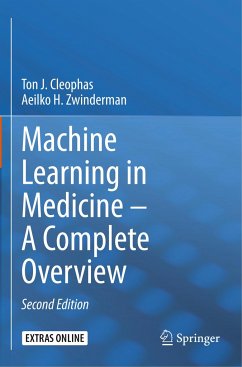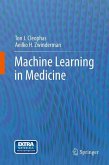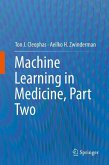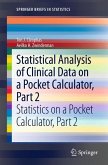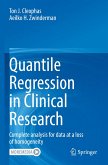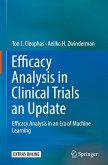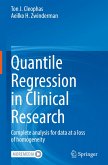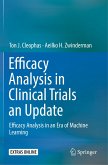- Broschiertes Buch
- Merkliste
- Auf die Merkliste
- Bewerten Bewerten
- Teilen
- Produkt teilen
- Produkterinnerung
- Produkterinnerung
Adequate health and health care is no longer possible without proper data supervision from modern machine learning methodologies like cluster models, neural networks, and other data mining methodologies. The current book is the first publication of a complete overview of machine learning methodologies for the medical and health sector, and it was written as a training companion, and as a must-read, not only for physicians and students, but also for any one involved in the process and progress of health and health care.
In this second edition the authors have removed the textual errors from…mehr
Andere Kunden interessierten sich auch für
![Machine Learning in Medicine Machine Learning in Medicine]() Ton J. CleophasMachine Learning in Medicine37,99 €
Ton J. CleophasMachine Learning in Medicine37,99 €![Machine Learning in Medicine Machine Learning in Medicine]() Ton J. CleophasMachine Learning in Medicine37,99 €
Ton J. CleophasMachine Learning in Medicine37,99 €![Statistical Analysis of Clinical Data on a Pocket Calculator, Part 2 Statistical Analysis of Clinical Data on a Pocket Calculator, Part 2]() Ton J. CleophasStatistical Analysis of Clinical Data on a Pocket Calculator, Part 237,99 €
Ton J. CleophasStatistical Analysis of Clinical Data on a Pocket Calculator, Part 237,99 €![Quantile Regression in Clinical Research Quantile Regression in Clinical Research]() Ton J. CleophasQuantile Regression in Clinical Research48,99 €
Ton J. CleophasQuantile Regression in Clinical Research48,99 €![Efficacy Analysis in Clinical Trials an Update Efficacy Analysis in Clinical Trials an Update]() Ton J. CleophasEfficacy Analysis in Clinical Trials an Update74,99 €
Ton J. CleophasEfficacy Analysis in Clinical Trials an Update74,99 €![Quantile Regression in Clinical Research Quantile Regression in Clinical Research]() Ton J. CleophasQuantile Regression in Clinical Research66,99 €
Ton J. CleophasQuantile Regression in Clinical Research66,99 €![Efficacy Analysis in Clinical Trials an Update Efficacy Analysis in Clinical Trials an Update]() Ton J. CleophasEfficacy Analysis in Clinical Trials an Update52,99 €
Ton J. CleophasEfficacy Analysis in Clinical Trials an Update52,99 €-
-
-
Adequate health and health care is no longer possible without proper data supervision from modern machine learning methodologies like cluster models, neural networks, and other data mining methodologies. The current book is the first publication of a complete overview of machine learning methodologies for the medical and health sector, and it was written as a training companion, and as a must-read, not only for physicians and students, but also for any one involved in the process and progress of health and health care.
In this second edition the authors have removed the textual errors from the first edition. Also, the improved tables from the first edition, have been replaced with the original tables from the software programs as applied. This is, because, unlike the former, the latter were without error, and readers were better familiar with them.
The main purpose of the first edition was, to provide stepwise analyses of the novel methods from data examples, but background information and clinical relevance information may have been somewhat lacking. Therefore, each chapter now contains a section entitled "Background Information".
Machine learning may be more informative, and may provide better sensitivity of testing than traditional analytic methods may do. In the second edition a place has been given for the use of machine learning not only to the analysis of observational clinical data, but also to that of controlled clinical trials.
Unlike the first edition, the second edition has drawings in full color providing a helpful extra dimension to the data analysis.
Several machine learning methodologies not yet covered in the first edition, but increasingly important today, have been included in this updated edition, for example, negative binomial and Poisson regressions, sparse canonical analysis, Firth's bias adjusted logistic analysis, omics research, eigenvalues and eigenvectors.
In this second edition the authors have removed the textual errors from the first edition. Also, the improved tables from the first edition, have been replaced with the original tables from the software programs as applied. This is, because, unlike the former, the latter were without error, and readers were better familiar with them.
The main purpose of the first edition was, to provide stepwise analyses of the novel methods from data examples, but background information and clinical relevance information may have been somewhat lacking. Therefore, each chapter now contains a section entitled "Background Information".
Machine learning may be more informative, and may provide better sensitivity of testing than traditional analytic methods may do. In the second edition a place has been given for the use of machine learning not only to the analysis of observational clinical data, but also to that of controlled clinical trials.
Unlike the first edition, the second edition has drawings in full color providing a helpful extra dimension to the data analysis.
Several machine learning methodologies not yet covered in the first edition, but increasingly important today, have been included in this updated edition, for example, negative binomial and Poisson regressions, sparse canonical analysis, Firth's bias adjusted logistic analysis, omics research, eigenvalues and eigenvectors.
Produktdetails
- Produktdetails
- Verlag: Springer / Springer International Publishing / Springer, Berlin
- Artikelnr. des Verlages: 978-3-030-33972-2
- 2. Aufl.
- Seitenzahl: 700
- Erscheinungstermin: 4. März 2021
- Englisch
- Abmessung: 235mm x 155mm x 35mm
- Gewicht: 1190g
- ISBN-13: 9783030339722
- ISBN-10: 3030339726
- Artikelnr.: 61129582
- Herstellerkennzeichnung
- Books on Demand GmbH
- In de Tarpen 42
- 22848 Norderstedt
- info@bod.de
- 040 53433511
- Verlag: Springer / Springer International Publishing / Springer, Berlin
- Artikelnr. des Verlages: 978-3-030-33972-2
- 2. Aufl.
- Seitenzahl: 700
- Erscheinungstermin: 4. März 2021
- Englisch
- Abmessung: 235mm x 155mm x 35mm
- Gewicht: 1190g
- ISBN-13: 9783030339722
- ISBN-10: 3030339726
- Artikelnr.: 61129582
- Herstellerkennzeichnung
- Books on Demand GmbH
- In de Tarpen 42
- 22848 Norderstedt
- info@bod.de
- 040 53433511
The authors are well-qualified in their field. Professor Zwinderman is past-president of the International Society of Biostatistics (2012-2015), and Professor Cleophas is past-president of the American College of Angiology (2000-2002). Professor Zwinderman is one of the Principle Investigators of the Academic Medical Center Amsterdam, and his research is concerned with developing statistical methods for new research designs in biomedical science, particularly integrating omics data, like genomics, proteomics, metabolomics, and analysis tools based on parallel computing and the use of cluster computers and grid computing. Professor Cleophas is a member of the Academic Committee of the European College of Pharmaceutical Medicine, that provides, on behalf of 22 European Universities, the Master-ship trainings "Pharmaceutical Medicine" and "Medicines Development". From their expertise theyshould be able to make adequate selections of modern methods for clinical data analysis for the benefit of physicians, students, and investigators. The authors have been working and publishing together for 18 years, and their research can be characterized as a continued effort to demonstrate that clinical data analysis is not mathematics but rather a discipline at the interface of biology and mathematics. The authors as professors and teachers in statistics at universities in The Netherlands and France for the most part of their lives, are concerned, that their students find regression-analyses harder than any other methodology in statistics. This is serious, because almost all of the novel methodologies in current data mining and data analysis include elements of regression-analysis, and they do hope that the current production "Regression Analysis for Starters and 2nd Levelers" will be a helpful companion for the purpose. Five textbookscomplementary to the current production and written by the same authors are Statistics applied to clinical studies 5th edition, 2012, Machine learning in medicine a complete overview, 2015, SPSS for starters and 2nd levelers 2nd edition, 2015, Clinical data analysis on a pocket calculator 2nd edition, 2016, Modern Meta-analysis, 2017 Regression Analysis in Medical Research, 2018 all of them published by Springer
Preface.- Section I Cluster and Classification Models.- Hierarchical Clustering and K-means Clustering to Identify Subgroups in Surveys (50 Patients).- Density-based Clustering to Identify Outlier Groups in Otherwise Homogeneous Data (50 Patients).- Two Step Clustering to Identify Subgroups and Predict Subgroup Memberships in Individual Future Patients (120 Patients).- Nearest Neighbors for Classifying New Medicines (2 New and 25 Old Opioids).- Predicting High-Risk-Bin Memberships (1445 Families).- Predicting Outlier Memberships (2000 Patients).- Data Mining for Visualization of Health Processes (150 Patients).- Trained Decision Trees for a More Meaningful Accuracy (150 Patients).- Typology of Medical Data (51 Patients).- Predictions from Nominal Clinical Data (450 Patients).- Predictions from Ordinal Clinical Data (450 Patients).- Assessing Relative Health Risks (3000 Subjects).- Measurement Agreements (30 Patients).- Column Proportions for Testing Differences between Outcome Scores (450 Patients).- Pivoting Trays and Tables for Improved Analysis of Multidimensional Data (450 Patients).- Online Analytical Procedure Cubes for a More Rapid Approach to Analyzing Frequencies (450 Patients).- Restructure Data Wizard for Data Classified the Wrong Way (20 Patients).- Control Charts for Quality Control of Medicines (164 Tablet Desintegration Times).- Section II (Log) Linear Models.- Linear, Logistic, and Cox Regression for Outcome Prediction with Unpaired Data (20, 55, and 60 Patients).- Generalized Linear Models for Outcome Prediction with Paired Data (100 Patients and 139 Physicians).- Generalized Linear Models for Predicting Event-Rates (50 Patients).- Factor Analysis and Partial Least Squares (PLS) for Complex-Data Reduction (250 Patients).- Optimal Scaling of High-sensitivity Analysis of Health Predictors (250 Patients).- Discriminant Analysis for Making a Diagnosis from Multiple Outcomes (45 Patients).- Weighted Least Squares for Adjusting Efficacy Data with Inconsistent Spread (78 Patients).- Partial Correlations for Removing Interaction Effects from Efficacy Data (64 Patients).- Canonical Regression for Overall Statistics of Multivariate Data (250 Patients).- Multinomial Regression for Outcome Categories (55 Patients).- Various Methods for Analyzing Predictor Categories (60 and 30 Patients).- Random Intercept Models for Both Outcome and Predictor Categories (55 Patients).- Automatic Regression for Maximizing Linear Relationships (55 Patients).- Simulation Models for Varying Predictors (9000 Patients).- Generalized Linear Mixed Models for Outcome Prediction from Mixed Data (20 Patients).- Two Stage Least Squares for Linear Models with Problematic Predictors (35 Patients).- Autoregressive Models for Longitudinal Data (120 Monthly Population Records).- Variance Components for Assessing the Magnitude of Random Effects (40 Patients).- Ordinal Scaling for Clinical Scores with Inconsistent Intervals (900 Patients).- Loglinear Models for Assessing Incident Rates with Varying Incident Risks (12 Populations).- Loglinear Models for Outcome Categories (445 Patients).- More on Polytomous Outcome Regressions (450 Patients).- Heterogeneity in Clinical Research: Mechanisms Responsible (20 Studies).- Performance Evaluation of Novel Diagnostic Tests (650 and 588 Patients).- Quantile - Quantile Plots, a Good Start for Looking at Your Medical Data (50 Cholesterol Measurements and 52 Patients).- Rate Analysis of Medical Data Better than Risk Analysis (52 Patients) .- Trend Tests Will Be Statistically Significant if Traditional Tests Are not (30 and 106 Patients).- Doubly Multivariate Analysis of Variance for Multiple Observations from Multiple Outcome Variables (16 Patients).- Probit Models for Estimating Effective Pharmacological Treatment Dosages (14 Tests).- Interval Censored Data Analysis for Assessing Mean Time to Cancer Relapse (51 Patients).- Structural Equation Modeling with SPSS Analysis of Moment Structures (Amos) for CauseEffect Relationships I (35 Patients).- Structural Equation Modeling with SPSS Analysis of Moment Structures (Amos) for Cause Effect Relationships II (35 Patients).- Firth's Bias-adjusted Estimates for Biased Logistic Data Models (23 Challenger launchings).- Omics Research (125 Patients, 24 Predictor Variables).- Sparse Canonical Correlation Analysis (12209 Genes in 45 Glioblastoma Carriers).- Eigenvalues, Eigenvectors and Eigenfunctions (45 and 250 Patients).- Section III Rules Models.- Neural Networks for Assessing Relationships that are Typically Nonlinear (90 Patients).- Complex Samples Methodologies for Unbiased Sampling (9,678 Persons).- Correspondence Analysis for Identifying the Best of Multiple Treatments in Multiple Groups (217 Patients).- Decision Trees for Decision Analysis (1004 and 953 Patients).- Multidimensional Scaling for Visualizing Experienced Drug Efficacies (14 Pain-killers and 42 Patients).- Stochastic Processes for Long Term Predictions from Short Term Observations.- Optimal Binning for Finding High Risk Cut-offs (1445 Families).- Conjoint Analysis for Determining the Most Appreciated Properties of Medicines to Be Developed (15 Physicians).- Item Response Modeling for Analyzing Quality of Life with Better Precision (1000 Patients).- Survival Studies with Varying Risks of Dying (50 and 60 Patients).- Fuzzy Logic for Improved Precision of Pharmacological Data Analysis (9 Induction Dosages).- Automatic Data Mining for the Best Treatment of a Disease (90 Patients).- Pareto Charts for Identifying the Main Factors of Multifactorial Outcomes (2000 Admissions to Hospital).- Radial Basis Neural Networks for Multidimensional Gaussian Data (90 persons).- Automatic Modeling for Drug Efficacy Prediction (250 Patients).- Automatic Modeling for Clinical Event Prediction (200 Patients).- Automatic Newton Modeling in Clinical Pharmacology (15 Alfentanil dosages, 15 Quinidine time-concentration relationships).- Spectral Plots for High Sensitivity Assessment of Periodicity (6 Years' Monthly C Reactive Protein Levels).- Runs Test for Identifying Best Analysis Models (21 Estimates of Quantity and Quality of Patient Care).- Evolutionary Operations for Health Process Improvement (8 Operation Room Settings).- Bayesian Networks for Cause Effect Modeling (600 Patients).- Support Vector Machines for Imperfect Nonlinear Data (200 Patients).- Multiple Response Sets for Visualizing Clinical Data Trends (811 Patient Visits).- Protein and DNA Sequence Mining.- Iteration Methods for Crossvalidation (150 Patients).- Testing Parallel-groups with Different Sample Sizes and Variances (5 Parallel-group Studies).- Association Rules between Exposure and Outcome (50 and 60 Patients).- Confidence Intervals for Proportions and Differences in Proportions (100 and 75 Patients).- Ratio Statistics for Efficacy Analysis of New Drugs 50 Patients).- Fifth Order Polynomes of Circadian Rhythms (1 Patient).- Gamma Distribution for Estimating the Predictors of MedicalOutcomes (110 Patients).- Index.
Preface.- Section I Cluster and Classification Models.- Hierarchical Clustering and K-means Clustering to Identify Subgroups in Surveys (50 Patients).- Density-based Clustering to Identify Outlier Groups in Otherwise Homogeneous Data (50 Patients).- Two Step Clustering to Identify Subgroups and Predict Subgroup Memberships in Individual Future Patients (120 Patients).- Nearest Neighbors for Classifying New Medicines (2 New and 25 Old Opioids).- Predicting High-Risk-Bin Memberships (1445 Families).- Predicting Outlier Memberships (2000 Patients).- Data Mining for Visualization of Health Processes (150 Patients).- Trained Decision Trees for a More Meaningful Accuracy (150 Patients).- Typology of Medical Data (51 Patients).- Predictions from Nominal Clinical Data (450 Patients).- Predictions from Ordinal Clinical Data (450 Patients).- Assessing Relative Health Risks (3000 Subjects).- Measurement Agreements (30 Patients).- Column Proportions for Testing Differences between Outcome Scores (450 Patients).- Pivoting Trays and Tables for Improved Analysis of Multidimensional Data (450 Patients).- Online Analytical Procedure Cubes for a More Rapid Approach to Analyzing Frequencies (450 Patients).- Restructure Data Wizard for Data Classified the Wrong Way (20 Patients).- Control Charts for Quality Control of Medicines (164 Tablet Desintegration Times).- Section II (Log) Linear Models.- Linear, Logistic, and Cox Regression for Outcome Prediction with Unpaired Data (20, 55, and 60 Patients).- Generalized Linear Models for Outcome Prediction with Paired Data (100 Patients and 139 Physicians).- Generalized Linear Models for Predicting Event-Rates (50 Patients).- Factor Analysis and Partial Least Squares (PLS) for Complex-Data Reduction (250 Patients).- Optimal Scaling of High-sensitivity Analysis of Health Predictors (250 Patients).- Discriminant Analysis for Making a Diagnosis from Multiple Outcomes (45 Patients).- Weighted Least Squares for Adjusting Efficacy Data with Inconsistent Spread (78 Patients).- Partial Correlations for Removing Interaction Effects from Efficacy Data (64 Patients).- Canonical Regression for Overall Statistics of Multivariate Data (250 Patients).- Multinomial Regression for Outcome Categories (55 Patients).- Various Methods for Analyzing Predictor Categories (60 and 30 Patients).- Random Intercept Models for Both Outcome and Predictor Categories (55 Patients).- Automatic Regression for Maximizing Linear Relationships (55 Patients).- Simulation Models for Varying Predictors (9000 Patients).- Generalized Linear Mixed Models for Outcome Prediction from Mixed Data (20 Patients).- Two Stage Least Squares for Linear Models with Problematic Predictors (35 Patients).- Autoregressive Models for Longitudinal Data (120 Monthly Population Records).- Variance Components for Assessing the Magnitude of Random Effects (40 Patients).- Ordinal Scaling for Clinical Scores with Inconsistent Intervals (900 Patients).- Loglinear Models for Assessing Incident Rates with Varying Incident Risks (12 Populations).- Loglinear Models for Outcome Categories (445 Patients).- More on Polytomous Outcome Regressions (450 Patients).- Heterogeneity in Clinical Research: Mechanisms Responsible (20 Studies).- Performance Evaluation of Novel Diagnostic Tests (650 and 588 Patients).- Quantile - Quantile Plots, a Good Start for Looking at Your Medical Data (50 Cholesterol Measurements and 52 Patients).- Rate Analysis of Medical Data Better than Risk Analysis (52 Patients) .- Trend Tests Will Be Statistically Significant if Traditional Tests Are not (30 and 106 Patients).- Doubly Multivariate Analysis of Variance for Multiple Observations from Multiple Outcome Variables (16 Patients).- Probit Models for Estimating Effective Pharmacological Treatment Dosages (14 Tests).- Interval Censored Data Analysis for Assessing Mean Time to Cancer Relapse (51 Patients).- Structural Equation Modeling with SPSS Analysis of Moment Structures (Amos) for CauseEffect Relationships I (35 Patients).- Structural Equation Modeling with SPSS Analysis of Moment Structures (Amos) for Cause Effect Relationships II (35 Patients).- Firth's Bias-adjusted Estimates for Biased Logistic Data Models (23 Challenger launchings).- Omics Research (125 Patients, 24 Predictor Variables).- Sparse Canonical Correlation Analysis (12209 Genes in 45 Glioblastoma Carriers).- Eigenvalues, Eigenvectors and Eigenfunctions (45 and 250 Patients).- Section III Rules Models.- Neural Networks for Assessing Relationships that are Typically Nonlinear (90 Patients).- Complex Samples Methodologies for Unbiased Sampling (9,678 Persons).- Correspondence Analysis for Identifying the Best of Multiple Treatments in Multiple Groups (217 Patients).- Decision Trees for Decision Analysis (1004 and 953 Patients).- Multidimensional Scaling for Visualizing Experienced Drug Efficacies (14 Pain-killers and 42 Patients).- Stochastic Processes for Long Term Predictions from Short Term Observations.- Optimal Binning for Finding High Risk Cut-offs (1445 Families).- Conjoint Analysis for Determining the Most Appreciated Properties of Medicines to Be Developed (15 Physicians).- Item Response Modeling for Analyzing Quality of Life with Better Precision (1000 Patients).- Survival Studies with Varying Risks of Dying (50 and 60 Patients).- Fuzzy Logic for Improved Precision of Pharmacological Data Analysis (9 Induction Dosages).- Automatic Data Mining for the Best Treatment of a Disease (90 Patients).- Pareto Charts for Identifying the Main Factors of Multifactorial Outcomes (2000 Admissions to Hospital).- Radial Basis Neural Networks for Multidimensional Gaussian Data (90 persons).- Automatic Modeling for Drug Efficacy Prediction (250 Patients).- Automatic Modeling for Clinical Event Prediction (200 Patients).- Automatic Newton Modeling in Clinical Pharmacology (15 Alfentanil dosages, 15 Quinidine time-concentration relationships).- Spectral Plots for High Sensitivity Assessment of Periodicity (6 Years' Monthly C Reactive Protein Levels).- Runs Test for Identifying Best Analysis Models (21 Estimates of Quantity and Quality of Patient Care).- Evolutionary Operations for Health Process Improvement (8 Operation Room Settings).- Bayesian Networks for Cause Effect Modeling (600 Patients).- Support Vector Machines for Imperfect Nonlinear Data (200 Patients).- Multiple Response Sets for Visualizing Clinical Data Trends (811 Patient Visits).- Protein and DNA Sequence Mining.- Iteration Methods for Crossvalidation (150 Patients).- Testing Parallel-groups with Different Sample Sizes and Variances (5 Parallel-group Studies).- Association Rules between Exposure and Outcome (50 and 60 Patients).- Confidence Intervals for Proportions and Differences in Proportions (100 and 75 Patients).- Ratio Statistics for Efficacy Analysis of New Drugs 50 Patients).- Fifth Order Polynomes of Circadian Rhythms (1 Patient).- Gamma Distribution for Estimating the Predictors of MedicalOutcomes (110 Patients).- Index.

